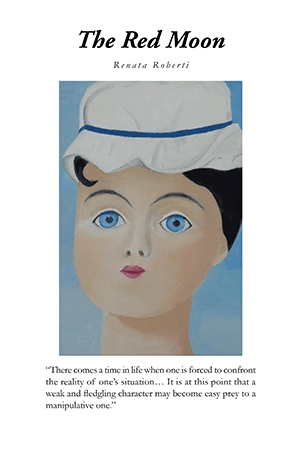The Red Moon
Detailed character studies add psychological suspense to this alluring mystery.
When her husband is found dead, and detectives try to figure out who is the killer, Mrs. Jane Althauss reflects on the choices she has made in her life—especially with her friend, Mary Ellen. In The Red Moon, Renata Roberti explores themes of loyalty and betrayal, friendship and marriage.
After the murder, Mary Ellen shows up to comfort Jane. She was once Jane’s best friend—or was she? As Jane entertains flashbacks of her relationship with her husband, she also recollects how her friendship with Mary Ellen began.
This novel is engaging, unfolding quickly as it moves between the present and flashbacks. Roberti’s writing is not complicated, and offers some simple but evocative descriptions that capture strong emotions between Jane and her husband; for example, it describes how their new home had no furniture and together the couple built a table, a bench, and some shelves.
There are aspects of the narrative that could use some tightening to remove repetitive descriptions, such as in the description of Giuseppe, the owner of La Luna Rossa restaurant, whose “watchful eyes” are referred to on several occasions. There are also some points where showing gives way to telling, and there are information dumps, especially in the interaction between the two detectives trying to solve the murder case: “They had finally identified a possible motive and felt confident that everything else would fall into place They now knew where to focus their attention.”
But while the main mystery of who murdered Dr. Althauss is investigated, there are other mysteries unfolding—those of the personalities of Jane and Mary Ellen and the true basis of their relationship. Roberti effectively conveys the interaction between the two women through their body language. For example, when, after John’s death, Mary Ellen has her hand under Jane’s arm and Jane sheds a tear: “Mary Ellen stiffened and retrieved her hand abruptly.” This image is somewhat undermined though, when Roberti, rather than allowing the description to convey the message, offers the explanation: “This silent expression of pain unsettled her, for she did not know how to handle it.”
Despite these distractions, the dynamic, intriguing, and detailed character study adds a psychological and suspenseful element to the mystery as a whole and keeps the narrative flowing.
The Red Moon is an alluring examination of a woman reevaluating her life and the choices she made with the people in it.
Reviewed by
Maya Fleischmann
Disclosure: This article is not an endorsement, but a review. The publisher of this book provided free copies of the book and paid a small fee to have their book reviewed by a professional reviewer. Foreword Reviews and Clarion Reviews make no guarantee that the publisher will receive a positive review. Foreword Magazine, Inc. is disclosing this in accordance with the Federal Trade Commission’s 16 CFR, Part 255.

